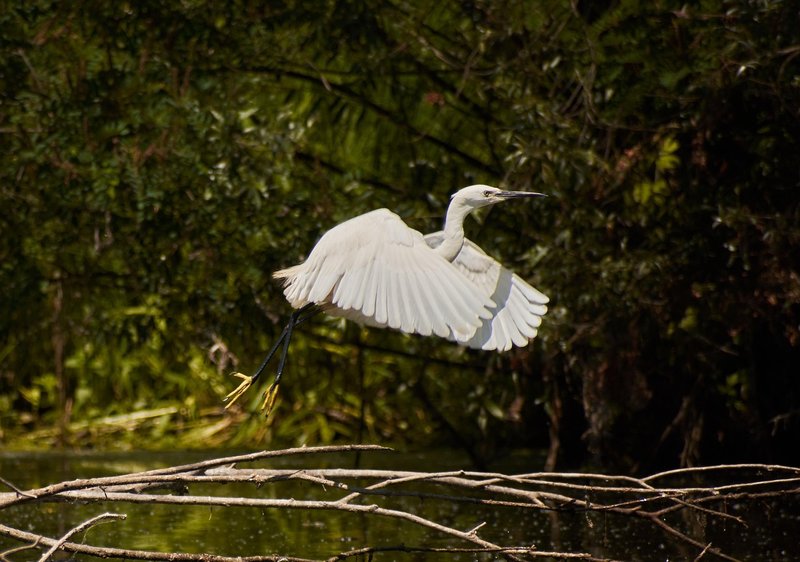
Imagine you’re standing by a pond, watching a heron gracefully stalk its prey. Suddenly, you spot a bird that looks almost identical, but something feels off. Maybe it’s a little smaller or has a different color. That’s the beauty of birdwatching; there’s always more to discover. By learning about the differences between herons and similar species, you sharpen your observation skills and deepen your knowledge of wildlife.
What is a Heron?
Herons are large wading birds typically found near water sources like lakes, rivers, and marshes. They belong to the family Ardeidae, which also includes egrets and bitterns. Herons are known for their long necks, sharp beaks, and distinctive hunting techniques. With over 60 species worldwide, including the Great Blue Heron and the Little Egret, these birds vary in size, color, and habitat preferences.
One of the standout features of herons is their slow and deliberate movement. When hunting, they often stand still for long periods, waiting patiently for fish or amphibians to come within striking distance. This method of hunting requires a keen eye and a lot of patience. It’s like being in a game of hide-and-seek, where the heron often wins with its stealth.
As you observe herons, you might notice their long legs, which allow them to wade through shallow waters. They also have special adaptations, like flexible necks and sharp talons, that make them excellent hunters. Understanding these traits is essential for distinguishing them from similar birds.
Common Lookalikes: Egrets
Egrets are often mistaken for herons because they share similar hunting grounds and physical characteristics. They’re also part of the Ardeidae family. Egrets tend to be smaller and have more slender bodies compared to herons. The Great Egret, for instance, boasts a striking white plumage and a long neck but remains more petite than herons.
One of the notable differences is in their plumage during breeding seasons. Egrets develop beautiful, long feathers called “aigrettes,” which they display to attract mates. Herons, on the other hand, don’t have this feature and may appear more uniform in their appearance.
You might also see egrets exhibiting more active behavior, such as chasing prey across the water, whereas herons rely on patience and stealth. This difference can help you identify which bird you’re looking at when you’re out by the pond or riverbank.
Another Lookalike: Bitterns
Bitterns are another group that can easily confuse birdwatchers. While they belong to the same family as herons and egrets, they have several distinct features. Bitterns are generally stockier and shorter, with a distinctive camouflage pattern that helps them blend into reeds and marshes. Their plumage is usually mottled, resembling the wetland vegetation where they reside.
Unlike herons, which are often seen standing gracefully at the water’s edge, bitterns are masters of concealment. When threatened, they’ll often freeze in place, using their unique coloration to hide from predators. This behavior can make it tough to spot them, resulting in many missed sightings by eager birdwatchers.
In terms of vocalization, bitterns have a deep, booming call that can sound quite different from the soft croaks of herons. If you hear a low, resonant boom coming from the marsh, there’s a good chance a bittern is nearby, while the herons will remain silent in their careful observation.
Identifying Characteristics of Herons
Now that you’ve learned about some common lookalikes, let’s focus on the distinctive traits of herons. Beyond their long legs and necks, herons have a unique flight pattern. Their wings are broad, and they tend to fly with their necks curled back, creating an unmistakable silhouette against the sky.
Herons also have long, pointed beaks that are built specifically for hunting fish and amphibians. Their beaks vary in size depending on the species, but they all share this predatory design. When hunting, herons can strike with incredible speed, making those long, sharp beaks essential tools for survival.
In addition, herons typically have a more elegant stance compared to their relatives. When resting, they often tuck their necks back against their bodies, giving them a poised and regal appearance. This graceful posture is a hallmark of herons and a great way to differentiate them from other wading birds.
Feeding Habits: How Herons Differ
Feeding is a significant area where herons showcase their unique behavior. Unlike many other waterbirds, herons are primarily visual hunters. They rely on their keen eyesight to spot prey from a distance. Once they identify a target, herons execute a precise, rapid strike, often returning with a fish or frog in their beak.
While egrets and bitterns also hunt for fish, their techniques might vary slightly. Egrets often forage in more open water, while bitterns prefer the dense reeds, making their hunting style more stealthy and less reliant on visual cues.
Herons have a more varied diet as well. They’re not just fish-eaters; they also consume small mammals, insects, and reptiles. This adaptability in diet allows herons to thrive in various habitats, from coastal areas to freshwater wetlands.
Breeding and Nesting Differences
Breeding behaviors among herons, egrets, and bitterns can significantly differ. Herons tend to nest in colonies, which can include dozens or even hundreds of nests close together. These communal nesting sites offer safety in numbers against predators.
Egrets also nest in colonies, but during the breeding season, their stunning plumage and courtship displays can be quite a spectacle. Observing courtship rituals can reveal various characteristics about their mating behavior, which is often quite different from that of herons.
Bitterns, in contrast, prefer a solitary approach to nesting. They build their nests deep within reed beds, which offer protection from potential threats. The solitary nature of bitterns’ nesting can make them harder to observe and study compared to their more social relatives.
In summary, while herons share some similarities with egrets and bitterns, each bird has its own unique set of traits that makes them special. Whether it’s the heron’s elegant posture, the egret’s stunning plumage, or the bittern’s masterful camouflage, these differences enrich our understanding of these beautiful creatures.
Next time you’re by the water, take a moment to appreciate the nuances that separate herons from their lookalikes. Understanding these differences not only enhances your birdwatching experience but also fosters a deeper respect for the diverse wildlife we share our world with. So, keep your eyes peeled and your camera ready—you never know what you might see!

